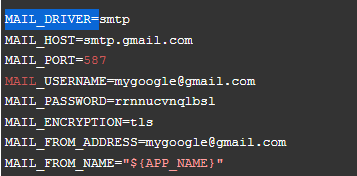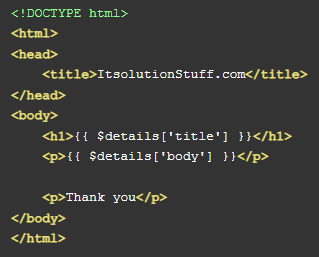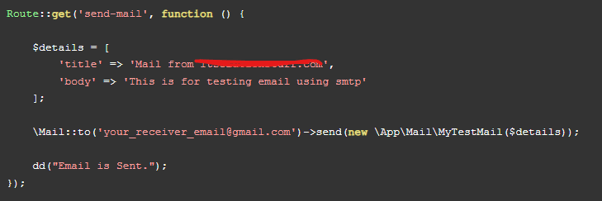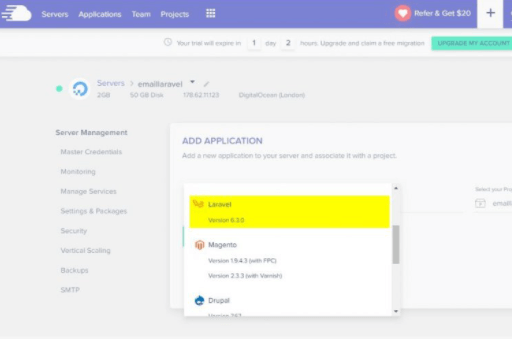Updated April 11, 2023

Introduction to Laravel Email
Email communication is a common feature in all web applications to send newsletters, updates, and magazines to collect the response or feedback. The PHP websites use their mailing policies to send emails. It is known as the Mail() PHP technique where the security is most compromised as there is no secure way to send and receive emails on the websites. But Laravel offered a few advanced techniques for secured email communication. It has distinct packages which are instant and available in the market to integrate the email functions effortlessly. In this article, creating, configuring, and integrating different mail services of Laravel is discussed in brief.
Overview of Laravel Email
The Laravel provides different tools to configure mail-in websites. A few options are listed below,
- Laravel offers drivers for Mailgun, Sparkpost, SMTP, SendMail and Amazon SES.
- It provides different options to schedule and queue mails.
- In Laravel, the user can make markdown support which is accessible in several frameworks. It supports creating attractive mailing templates with the panel, button, tab, and so on.
- The user can attach files, different templates of various formats and it is configured in such a way to support all types of file formats in the Laravel templating systems.
- Localization techniques are available to set the preferred languages for the users.
Creating Laravel Email
In Laravel, every type of mail is sent from the application which is marked as a mailable class. The user can create any mailable class with any name and paste the standard command on the SSH terminal.
It makes use of all the free features available in the SwiftMailer library to send emails without any hassles. The templates of the email are fed into the same view which can imply blade syntax and push the data into the templates.
The below shows the standard attributes and syntax of send functions.
The standard syntax is void send (string| array $view, array $data, Close|string $callback)
The parameters used are $view (string | array) to view the name which comprises an email message. $data (array) to pass the view on data. $callback is a closure callback that receives the instance message which enables to customize the subjects, recipients, and other parts of the email message. These values return nothing and the description can be sent in the mail.
The third argument closure message instance is also comprised of other instances. The following messages and functions which are used for editing the messages is shown below,
$message -> subject ('welcome to educba')
$message -> from (mail@educba.edu, "EDUCBA")
$message -> to (mail@educba.edu "EDUCBA")
Few of the common methods are,
$message → sender (mail@educba.edu "EDUCBA");
$message → returnPath ((mail@educba.edu);
$message → cc (mail@educba.edu "EDUCBA");
$message → bcc (mail@educba.edu "EDUCBA");
$message → replyTo (mail@educba.edu "EDUCBA");
$message → priority (3);
To assign the embed files, the user can choose,
$message -> attach ('path /to/attachment.txt');
$message -> embed ('path /to/attachment.txt');
$message -> attach ('path /to/attachment.pdf');
$message -> attach ('path /to/attachment.jpg');Laravel Email Installation
To avoid server-level issues, the user can install the Laravel from the cloud-managed platform to the server as it manages all the server-level issues and provides great stacks of database techniques and cache management. It can be configured free if is signed by an account. There are multiple options available for Laravel mail configuration. It offers a simple API with an advanced Swiftmailer library with adaptive drivers for Mailgun, Postmark, SMTP, Amazon SES, and Sendmail to enable the mails to send it quickly according to the format and choice of the user.
How to Send Email via Laravel?
The email via Laravel can be sent in text or HTML format. The user can indicate the format and type of the mail which can be passed as the first argument and the default is selected as HTML.
PHP artisan make: mail cloud hosting product
Once the above command is executed, the main class is created with the given name inside the cloud hosting product, so the user can create the file inside the app\ mail\ cloud hosting product.php
The user can define the mail address which needs to be communicated.
*/
public function build()
{
return $this -> from ("example@educba.com")
> view ('emails.cloud hosting. Product.php);
}If the user has the same address across all the web applications, then it needs to be configured in the config file inside the folder config/ mail.php file inside the Laravel to use the code.
'from' => [ 'address' => ("example@educba.com") 'mail name' => 'Application Name'],Inside the mailable class, the build technique is used in the view technique to mention the template which is used for mail communication to render the contents of the mail.
public function build ()
{
return $this -> view ('emails.cloud hosting. Product.php);
}To view the data and functions, the user can use all the options from mail templates to prevent the rendering of mails and can be implied effectively in two ways,
The public property is defined in the mailable class which automates the availability of views when the concerned data is provided. For example, if the user passes the constructor of a mailable class, he can configure the data in public properties which is defined inside the class. Once the data is configured to public property it automates the availability view. The template of Laravel mail can be configured as follows,
<div>
Name : { $name }
<//div>To configure the routes, create the route by writing the code to the web.php file.
Route :: get ('/send/mail’, 'HomeController@mail');The controller file is created with the standard user-preferred name and it should be scripted along with the home controller code.
public function mail ()
{
$name = 'educba';
Mail:: to ("educba@educba.com') -> send (new SendMail ($name);
return 'mail sent success';
}Conclusion
This is an overview of sending emails with Laravel and how it can be configured to transfer mail in the websites in a secured method and how it can be implied accordingly.
Recommended Articles
We hope that this EDUCBA information on “Laravel Email” was beneficial to you. You can view EDUCBA’s recommended articles for more information.





